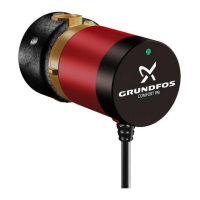4.1.1.3 Submerged installation on auto coupling
Pumps for permanent installation can be installed on
a stationary auto coupling and operated completely or
partially submerged in the pumped liquid.
Before installing the auto-coupling base unit, ensure
the quality and strength of the concrete foundation.
See the pull-out strengths required for anchor bolts in
the table below. Weld the threaded bushings to the
steel reinforcement in the concrete to ensure
adequate pull-out strength.
Pull-out strengths for anchor bolts
Auto-coupling
base unit
Bolts
Pull-out strength
[kN]
DN 100
4 x M16
5
DN 125/150 * 8
DN 200
4 x M24
16
DN 250 30
DN 300 40
DN 500
6 x M30
40
DN 600 40
* Pump outlet DN 125 and base plate outlet DN 150.
For auto-coupling installations, types S
and C, including DN 250 and above, the
guide shoe is mounted on the outlet
flange.
1. Drill mounting holes for the guide-rail bracket on
the inside of the pit and fasten the guide-rail
bracket with two anchor screws.
2. Place the auto-coupling base unit on the bottom
of the pit. Use a plumb line to establish the correct
position. Fasten the auto coupling with anchor
bolts. If the bottom of the pit is uneven, support
the auto-coupling base unit so that it is level when
being fastened.
3. Connect the outlet pipe in accordance with the
generally accepted procedures and without
exposing the pipe to distortion or tension. Do not
allow the auto coupling to carry loads from the
weight of the pipes.
4. Fit the guide rails. An intermediate guide-rail
bracket is required if guide rails are more than 6 m
long. Place the guide rails on the auto coupling,
then place the guide-rail bracket on the guide rails
and fasten it to the pit wall. Tighten the anchor
bolts.
5. Clean out the debris before lowering the pump
into the pit.
6. Before lowering the pump into the pit, check the
cables for cuts or ruptures.
7. Slide the guide shoe of the pump between the
guide rails and lower the pump into the pit by a
certified chain secured to the lifting bracket. When
the pump reaches the auto-coupling base unit, it
automatically connects.
8. Hang up the end of the chain on a suitable hook
at the top of the pit, so the chain cannot come into
contact with the pump.
9. Adjust the length of the motor cables, but make
sure to have enough cable length for service.
Make sure that the cables are not sharply bent or
pinched. Fix the cables at the top of the pit.
10. Connect the motor cables and the sensor cable.
Avoid pipe tension at flanges and bolts.
The free end of the cables must not be
submerged, as water may penetrate
through the cables into the motor.
The pull-out strengths are stated without
safety factor. The required safety factor
may depend on the materials and the
methods used for anchoring.
4.1.2 Submerged installation, portable
1. Fit the ring stand to the pump inlet flange.
2. Fit a 90 ° elbow to the pump outlet port and
connect the outlet pipe or hose. If a hose is used,
make sure it does not buckle and the inside
diameter matches the outlet port.
3. Lower the pump into the liquid by a chain secured
to the lifting bracket of the pump. Place the pump
on a plain, solid foundation. Make sure that the
pump is hanging from the chain and not from the
cables.
4. Hang up the end of the chain on a suitable hook
at the top of the pit, so the chain cannot come into
contact with the pump.
5. Adjust the length of the motor cables by coiling
them up on a relief fitting to ensure the cables are
not damaged during operation. Fasten the relief
fitting to a suitable hook. Make sure that the
cables are not sharply bent or pinched.
6. Connect the motor cables and the control cable, if
any.
19
English (GB)

